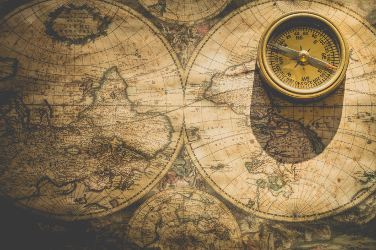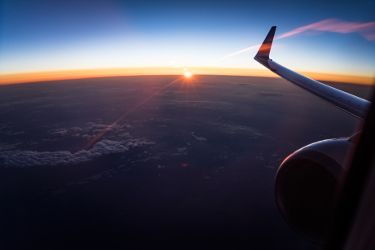European sea exploration
I’ve always been fascinated by the maritime history of 15th–18th century Europe. Since this period is largely characterized by exploration and colonization, it’s often referred to it as the Age of Discovery (AoD). Compared to the stagnant nature of the preceding Middle Ages, the AoD is characterized by a tremendous increase in trade and wealth, as well as a substantial boost in religious, artistic, and scientific development. Its impact can still be felt to this day, decades after most former European superpowers “allowed” their last colonies to govern themselves.

This is what European explorers dealt with instead of iPhones
At some point it struck me that none of that would’ve been possible—and indeed wasn’t for most nations at the time—were it not for a substantial advancement in the following fields:
- Optics, and in particular the telescope: Being able to clearly see what’s coming over the horizon is a big boost to exploration. But it’s just not possible to advance in telescope-making if you don’t understand basic rules of (geometric) optics.
- The study of time and its measurement: Timing sunsets, sunrises, or meridian transits—i.e., when it’s exactly noon, by strict definition and not nation-wide synchronized clocks—in different parts of the world is absolutely essential for accurately determining your latitude on earth.
- Designing and building ships: This one’s pretty obvious, since there’s no way to explore the oceans and colonize far-away lands without large and fast ships. To gain an edge in terms of size and speed, you need to understand quite a bit of physics (e.g., buoyancy, fluid drag, and material properties).
- Astronomy, particularly the use of celestial reference points: Another obvious one, which is nonetheless important to mention. Perhaps the most well-known method (at least in the Northern Hemisphere) is determining the altitude of the North Star, which coincides with your longitude. Cool, huh?
I know the above list is probably not exhaustive, but I can’t think of any other research field that had a stronger influence on the AoD. (No, the compass is just a simple tool.) In any case, I thought merging the relevant maths and physics should produce a few nice thought-sparks.

There’s a reason the telescope used to be a symbol of progress
Let’s now try and understand why ships time were as big as they were at the time, and why they moved as fast as they did. To (drastically) simplify things, I’ll henceforth assume that ships are hollow cubes of side L, with a sail of area L2 on top. I know this sounds like an over-simplification, but it’s meant to reflect the accuracy of the kind of big-picture approach I’m employing. You’ll be surprised by how much you can learn from studying box-shaped ships.

Hey, look, a carton ship!
The first thing to notice here, is that sailing ships can, at best, go as fast as the wind is blowing. Judging from personal experience, I’d say typical wind-speeds are vwind ~ 5 cm/s ~ 10 km/h (year-round average). This seems to supported by some evidence, at least. Generally speaking, a ship cruising at a constant speed vship is always under the influence of two counteracting forces: the force exerted by the wind on the sails, and the drag force from the water on the submerged part of the ship. Equating these two forces, and assuming most of the ship is submerged, yields
where ρair ~ 1 kg/m3 and ρwater ~ 103 kg/m3 are the density of air and water, respectively. The above is, of course, only meant as an estimate; in reality, (1) is probably a lower limit on what a sailing ship can do. In fact, one obvious thing you can do to increase vship is give the ship an elongated shape, thereby reducing the drag force exerted by the water. In any case, let’s just take vship ~ 5 km/h as a reasonable compromise.

If (1) looks like Einstein’s relativity, you should stop reading...
Since we’re interested in sea exploration and colonization, our imaginary ship needs to travel over a good fraction of the earth’s circumference (40,000 km or so); let’s say ~ 10,000 km. With a speed of ~ 5 km/h, this can be done in 2,000 hours or so, which is like an entire season worth of traveling (e.g., spring, when the weather’s reasonably good). Which, if you’re even vaguely familiar with the relevant history, is indeed what people had to deal with back then. Remember that before complaining to the whole world about your flights that are delayed or too long.

Next time you enjoy such a view, remember to be grateful
Since we’re talking about an age of colonization, we want our ship to carry a few families and probably just as many crew members, so on the order of 50 passengers in total. Assuming each person requires daily provisions (food and water, mostly) of about 5 kg, I’ll be conservative and say our ship should be able to carry a cargo of ~ 100 tons. That’s like a herd of African bush elephants, so you know our imaginary ship has to be big.

If you want to colonize earth, you need a ship that can carry them
To see exactly how big our imaginary ship needs to be to carry all that stuff, we have to do a little more physics: For our ship to remain afloat, buoyancy (i.e., the weight of the displaced water) must always counterbalance its the ship’s net weight, Wship (hull + crew + provisions). Assuming the hull’s weight is, at worst, comparable to our previous estimate (so that Wship ~ 100 tons), we get
The only potential problem with our calculation is that Whull may be significantly larger than 100 tons, contrary to what we assumed to derive (2). To test this, we’ll say the hull is a shell of thickness t ~ 10 cm (from everyday observations); since wood floats its density is comparable to that of water, so Whull ~ 6·L2·t·ρwater ≳ 10 tons. Our calculations are therefore self-consistent, even if ship hulls were ridiculously thick (t ~ 1 m).

Ignoring surface tension and demonic clowns, everything floats for the same reason
By now, certain aspects of European sea exploration shouldn’t be as mysterious anymore. In particular, it shouldn’t come as a surprise that European explorers used huge ships, sailing with the seasons to cross entire oceans. Let this be a homage to those brave explorers that made today’s life possible.
All these different aspects, including size and cargo weight, are remarkably well-constrained by simple physical principles. History isn’t just a bunch of random events; a good chunk of it was shaped by the laws of nature.